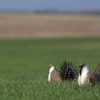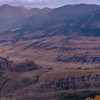The greater sage grouse lives in the extensive sagebrush steppe that spans parts of Washington, Oregon, California, Nevada, Utah, Idaho, Montana, Wyoming, Colorado, the Dakotas, Alberta and Saskatchewan.
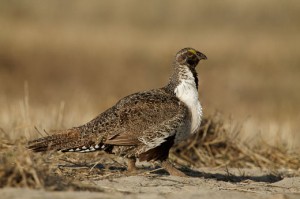 As of March 2010, the U.S. Fish and Wildlife Service (FWS) estimated that the species now is found in approximately 160 million acres of land, 56% of its historic range.[i] Wyoming is the stronghold of the species: 54% of the sage grouse in the world can be found in Wyoming on 32 million acres of sagebrush habitat. Wyoming is thus the key to sage grouse conservation.
As of March 2010, the U.S. Fish and Wildlife Service (FWS) estimated that the species now is found in approximately 160 million acres of land, 56% of its historic range.[i] Wyoming is the stronghold of the species: 54% of the sage grouse in the world can be found in Wyoming on 32 million acres of sagebrush habitat. Wyoming is thus the key to sage grouse conservation.
Collaboration is more easily voiced than embodied when it comes to wildlife conservation in the Rocky Mountain West. Public and private land users and interests, state and federal governments, and the constituencies they serve tend to compete rather than cooperate. For decades battle lines have been drawn between traditional, agrarian perspectives on wildlife conservation and the competing goals and objectives of the modern environmental movement. These lines have been exacerbated by tension between state and federal governments, but efforts to protect sage grouse might be able to break that pattern.
The federal Endangered Species Act (ESA) has triggered endless conflict. The Yellowstone wolf reintroduction, referred to as “the Wolf Wars” by some, offers a prime example in the West. The FWS introduced an experimental population of gray wolves into Yellowstone National Park in 1995, and their subsequent dispersal beyond the Park’s boundaries has rekindled conflict over control of wolves and wolf management. In the years leading up to and since wolf reintroduction ranchers filed suits to stop reintroduction or reduce wolf numbers, environmentalists filed suits to strengthen or maintain protections for wolves, and state governments filed suits to delist wolves and transfer management from the FWS to the states. Meanwhile wolves have been listed, downlisted, delisted, relisted, partially delisted, and fully delisted, and the fight continues as vehemently as ever. In spring of 2013 two coalitions of environmental groups were trying to consolidate their suits against the FWS for allowing Wyoming’s wolf management plan, and Wyoming Governor Matt Mead is protesting that consolidation. Meanwhile, the FWS has proposed delisting gray wolves across the entire United States, a move opposed by wolf advocates.
The struggle over wolf management reflects much of the history of the ESA, and the high-profile species conflicts with which it is commonly associated—the snail darter, grizzly bear, northern spotted owl, golden-cheeked warbler, Pacific salmon, and the Colorado River squawfish (now known as the northern pikeminnow) to name a few. As species continue to decline in numbers and range, the Act is invoked more and more frequently to arrest further declines and provide additional regulatory protections to support species conservation, and hopefully, to promote species recovery. The various participants in the debate—including conservation and socioeconomic interests—have become adept at pursuing their respective objectives through whatever means available, including efforts to obtain the intervention of the federal judiciary or Congress.
This use of power-based advocacy strategies is not necessarily the most efficient way to accomplish the conservation and recovery of at-risk species. Nor is it a path pre-ordained by, or a necessary result of, the Act itself. It has, however, become “business as usual.” At a time when our appreciation of the threats faced by wildlife has expanded dramatically, adoption of a different philosophy regarding the conservation of species at risk is long overdue. Properly viewed, the ESA itself can serve as the inspiration for growth in our approach to conservation.
Perhaps the most valuable role the ESA can play from a societal perspective is to motivate us to avoid a species being listed altogether by accomplishing timely and effective species conservation. In the case of the greater sage grouse, that is exactly what is going on. In contrast to the wolf saga, broad-scale efforts are underway to cut off similar struggles over sage grouse conservation. These activities are of particular interest in Wyoming, in large part because of the potential for sage grouse to affect the cultural and economic future of the state. Wyoming represents the heart of sage grouse country. And, although not as iconic as the gray wolf, a sage grouse listing would have the potential to impact public land uses in Wyoming to a far greater extent than does the wolf.
It is of course quite possible that sage grouse conservation efforts involving the ESA may follow a path similar to that of the wolf, with vested interests of all persuasions battling it out in various legal and political forums. On the other hand, recent collaborative initiatives at the state, federal and local levels show the potential to revolutionize the manner in which at-risk species are conserved in the United States. The principal question they pose is whether we can learn and act quickly enough to avoid repeating history.
A contentious start for grouse
The story of the greater sage grouse initially unfolded similarly to that of the wolf. The FWS was first petitioned to list the greater sage grouse as an endangered species in 2002. A second, and then a third, listing petition followed in 2003. Concurrently other efforts were mounted to list western populations of greater sage grouse, leading to administrative action and litigation. FWS ultimately determined that such populations should be evaluated as a part of the greater sage grouse listing process.
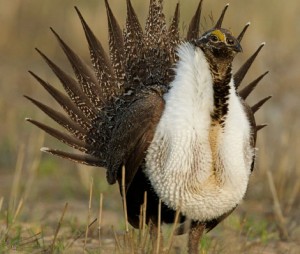 In January 2005, FWS announced its decision that the greater sage grouse was neither threatened nor endangered, and that listing thus was not warranted.[ii] In 2006, FWS was sued over that decision, and in 2007, the Federal District Court in Idaho overturned the agency’s decision.
In January 2005, FWS announced its decision that the greater sage grouse was neither threatened nor endangered, and that listing thus was not warranted.[ii] In 2006, FWS was sued over that decision, and in 2007, the Federal District Court in Idaho overturned the agency’s decision.
Upon further review, in 2010 FWS announced that listing the greater sage grouse as a threatened species was warranted, but was precluded by other, higher conservation priorities, a decision that was eventually challenged.[iii] FWS currently is reconsidering whether the species should be listed, and that decision is due in 2015.
Sage grouse litigation was not limited to the listing lawsuits mentioned above; other suits were filed challenging the Bureau of Land Management’s (BLM) treatment of sage grouse under its resource management plans. Such lawsuits found fertile ground. One challenged 18 resource management plans in Idaho, Montana, Utah, California, Wyoming, and Nevada, on the grounds that BLM had failed to consider the cumulative impacts of BLM’s management decisions on sage grouse populations.[iv] Another case challenged BLM’s environmental impact analysis of increased grazing on 1.4 million acres of sage grouse habitat in southern Idaho given recent fires that burned over 400,000 acres in the area.[v] Both were determined in favor of the plaintiffs, requiring BLM to update plans with greater consideration of impacts to sage grouse.
Legally speaking, in determining whether a species should be listed under the ESA as threatened or endangered, the FWS must consider five factors: (1) threats to its habitat; (2) overconsumption of the species; (3) disease or predation; (4) the inadequacy of existing regulatory mechanisms; and (5) other natural or manmade factors affecting its continued existence.[vi] In considering a listing decision, the Service must limit its review to “the best scientific and commercial data available,” taking into account the conservation efforts of states and other entities.[vii]
Many conservation efforts underway are relevant to the agency’s evaluation of the fourth factor above, namely whether “existing regulatory measures” are adequate to provide for the conservation of the species. To be considered, however, such conservation measures must be concrete, sure to be implemented, and sufficient biologically to protect the species.[viii] The weight that could be given to a particular conservation effort—such as a state core area policy—will be based on the degree of certainty that the conservation effort will be implemented and that it will be biologically effective.[ix]
Wyoming leads the way
Sage grouse conservation efforts at the federal and state levels proceeded at a somewhat desultory pace following the initial listing petitions. BLM issued a “National Sage Grouse Habitat Conservation Strategy” in November 2004, as well as guidance documents pertaining to sage grouse habitat conservation and management. The states, too, had either sage-grouse-specific or general wildlife conservation authorities applicable to the conservation of the species. And in 2006, the Western Association of Fish and Wildlife Agencies issued a “Greater Sage Grouse Comprehensive Conservation Strategy.” The efforts of the time, however, with a few exceptions, did not afford substantial protection for the species. In its 2010 finding FWS concluded that with the possible exception of new conservation strategies adopted by Wyoming and Colorado, the existing state-level sage grouse conservation plans were not sufficient to conserve the species. Similarly, FWS concluded that the sage grouse conservation strategies adopted by the BLM and the U.S. Forest Service did not afford adequate conservation to avoid the need for a listing. In aggregate, FWS found the absence of adequate sage grouse conservation regulatory regimes to be a “significant threat to the species, now and in the foreseeable future.”[x]
The Service’s 2010 finding notwithstanding, the landscape of sage grouse conservation efforts in Wyoming and elsewhere in the West had begun to change. State fish and wildlife agencies had long managed sage grouse with varying levels of urgency concerning species health. In 2007 the intensity of such efforts ramped up, catalyzed by the creation of a Sage Grouse Implementation Team by the Governor of Wyoming. The team, comprised of representatives of federal, state, and county governments, energy developers, mining companies, private landowners, and conservation organizations, was 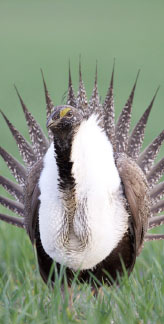 charged by then-Governor Dave Freudenthal with developing a long-term, science-based cooperative strategy for greater sage grouse conservation.
charged by then-Governor Dave Freudenthal with developing a long-term, science-based cooperative strategy for greater sage grouse conservation.
The team’s efforts led Governor Freudenthal to issue Executive Order 2008-02, which established a “core area population strategy,” intended to provide meaningful conservation benefits for greater sage grouse. The “Core Area Policy,” as it subsequently came to be known, provides that the State of Wyoming will: (1) focus on maintenance and enhancement of sage grouse habitat and populations within the core habitat areas; (2) permit new development within the core areas “only when it can be demonstrated by the state agency that the activity will not cause declines in greater sage grouse populations;” and (3) provide incentives to encourage development outside the core areas.
Eighty-two percent of Wyoming’s sage grouse are found within the core areas identified in the Policy, which encompasses federal, state and private lands within Wyoming. The State has broad authority to enforce the Core Area Policy on non-federal land, making this a landmark in sage grouse conservation. The policy was readopted by now-Governor Matt Mead in 2011 as Executive Order 2011-5. FWS endorsed the policy, stating that its full implementation could preclude the need to list the greater sage grouse as an endangered species, depending on what happened with grouse outside Wyoming’s borders.
Wyoming led the effort, but is not alone in pursuing increased sage grouse conservation measures modeled along the “core area” concept. In 2008 and 2009 Colorado,[xi] Montana,[xii] and Utah[xiii] each resolved to map and adopt a core area protection plan as part of their statewide sage grouse conservation strategies. Oregon implemented a core area strategy in 2011[xiv] and Idaho in 2012.[xv] And in 2011 Secretary of Interior Ken Salazar referenced the Wyoming core area plan in his commitment to have the BLM revise 22 resource management plans to better take into consideration sage grouse conservation needs.
To enhance west-wide, state-level sage grouse conservation, on December 9, 2011, Governor Mead of Wyoming and Secretary Salazar hosted a sage grouse conservation meeting in Cheyenne involving representatives of Colorado, Idaho, Nevada, North and South Dakota, Oregon, and Utah; national directors of the FWS, BLM, and the Natural Resources Conservation Service; and the Deputy Regional Forester for the Intermountain Region of the U.S. Forest Service. The meeting focused on developing a coordinated, landscape-level greater sage grouse conservation strategy. The desired outcome was a proactive, collaborative conservation effort at the state, federal and local levels that would obviate the need to list the species under the ESA.[xvi] Following the meeting, Wyoming Governor Mead and Colorado Governor John Hickenlooper took the reins of a new Sage Grouse Task Force. The Task Force’s purpose was to identify and coordinate high-priority actions to restore fragmented habitat and maintain or increase sage grouse populations in western states.[xvii]
In June of 2012 the Sage Grouse Task Force submitted a “Process for Developing a Range-wide Conservation Plan for Sage Grouse.”[xviii] The report lists eight action items to coordinate sage grouse conservation efforts among western states.
Collaborative sage grouse conservation expands
Increased focus on sage grouse conservation is not limited to state government. Multiple conservation efforts are ongoing both at the federal level and in the private sector.
In 2010 the BLM updated its 2004 “National Sage Grouse Habitat Conservation Strategy.”[xix] And in August 2011, the agency established a charter for a “National Greater Sage Grouse Planning Strategy,” to evaluate the adequacy of BLM Resource Management Plans to conserve greater sage grouse. The objective for the planning strategy was to develop new or revised regulatory mechanisms to conserve and restore greater sage grouse and its habitat on BLM lands range wide and long term.[xx] The agency subsequently adopted instructional memoranda that provide interim sage grouse conservation policies and procedures to deal with ongoing and proposed public lands activities and land-use authorizations,[xxi] and to consider greater sage grouse conservation measures during the land-use planning process.[xxii]
In late 2011, following an example set earlier in Wyoming, BLM and the U.S. Forest Service initiated a National Environmental Policy Act process to support the revision of those agencies’ land use and land management plans in portions of the western states where sage grouse live. These revisions are intended to incorporate consistent conservation objectives and measures to protect sage grouse and sage grouse habitat on BLM and Forest Service lands by September of 2014.[xxiii]
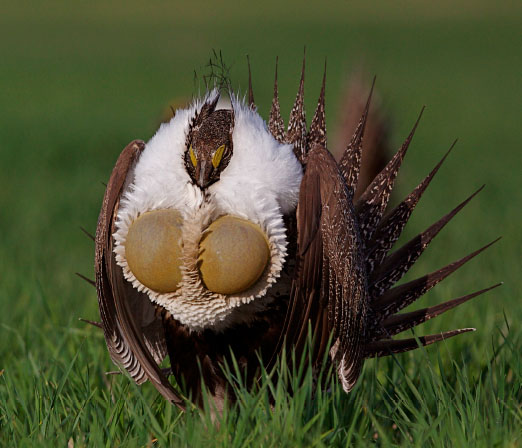 In related activities, the Department of Agriculture Natural Resource Conservation Service established a Sage Grouse Initiative in 2010 that focused on using conservation grant and technical assistance programs to support ranchers in improving sage grouse habitat and rangelands productivity.[xxiv] In 2011, the Department of Agriculture announced an additional $18.2 million program to help ranchers in Wyoming, Idaho and Utah conserve critical sage grouse habitats through its Grassland Reserve Program.[xxv]
In related activities, the Department of Agriculture Natural Resource Conservation Service established a Sage Grouse Initiative in 2010 that focused on using conservation grant and technical assistance programs to support ranchers in improving sage grouse habitat and rangelands productivity.[xxiv] In 2011, the Department of Agriculture announced an additional $18.2 million program to help ranchers in Wyoming, Idaho and Utah conserve critical sage grouse habitats through its Grassland Reserve Program.[xxv]
And on March 8, 2012, Agriculture Secretary Vilsack and Secretary of the Interior Salazar announced the establishment of the Working Lands for Wildlife partnership program, a $33 million program to work with farmers, ranchers, and forest landowners to restore, manage, and protect habitats for at-risk species and game animals. Greater sage grouse are among the first seven species that were selected for inclusion in the program.[xxvi]
To inform its upcoming 2015 listing decision and to promote collaborative conservation efforts range wide, the FWS convened a sage grouse Conservation Objectives Team of state and agency representatives. In February 2013 this team released the “Greater Sage-grouse (Centrocercus urophasianus) Conservation Objectives: Final Report,”[xxvii] an unprecedented document over 100 pages long outlining recommendations for a coordinated conservation effort across ten states. It spells out specific aspects of conservation concern that states and federal agencies can focus on to reduce threats to sage grouse so that the species is no longer in danger of extinction.
FWS also has worked with states to develop Candidate Conservation Agreements (CCAs) and Candidate Conservation Agreements with Assurances (CCAAs), two voluntary tools to recover potentially threatened or endangered species and negate the need to list them.[xxviii] CCAAs, to date the more substantial of the two agreements, apply only on nonfederal lands. Property owners (usually private individuals) agree to conservation measures drawn up with the FWS. In exchange, they get assurances that—should the species be listed—no additional land, water, or resource use restrictions will be imposed beyond what is already provided in the agreement.[xxix] CCAs, on the other hand, do apply on federal lands, and do not come with assurances or permits to allow activities that would harm a species should it be listed. In some cases, federal agencies have been reluctant to enter into CCAs for species conservation because they perceive that such agreements offer little in return for enacting conservation measures.
In the western United States, where federal and nonfederal lands are intertwined, the need for an effective public lands counterpart to CCAAs has become increasingly clear. In the case of sage grouse, some ranchers have expressed willingness to enter CCAAs on their private land only so long as an adjacent (and consistent) CCA exists for the federal land grazing allotments that rancher uses.
The Oregon Cattlemen’s Association approached the BLM in Oregon to develop, with the FWS, a conservation agreement for sage grouse on public grazing lands. The BLM, FWS, and the Oregon Cattlemen’s Association signed the “Greater Sage-Grouse Programmatic Candidate Conservation Agreement for Rangeland Management Practices on Bureau of Land Management Lands in Oregon” on May 30, 2013. The purpose of the agreement is to protect sage grouse on BLM grazing allotments. A parallel CCAA for sage grouse on nonfederal agricultural lands in southeast Oregon will be finalized later this year. Both are voluntary, and provide a template for a rancher who chooses to join the agreement. Both also provide the necessary “regulatory mechanisms” the FWS will be looking for when it determines whether to list sage grouse as an endangered species in 2015.
The FWS is also working on a statewide CCAA for Wyoming ranch managers to voluntarily enhance sage grouse habitat. Conservation measures called for in the “Greater Sage-Grouse Umbrella CCAA for Wyoming Ranch Management” include maintaining contiguous habitat, controlling invasive vegetation species, and maintaining or enhancing sagebrush communities.[xxx]
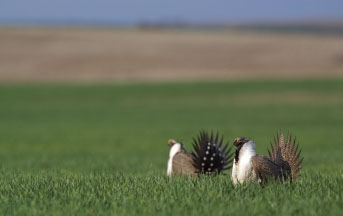 Private-sector interests including members of the agricultural and ranching communities likewise are pursuing the development of sage grouse CCAAs. One of the first such agreements was adopted in 2010 when the FWS entered into a programmatic agreement in Idaho.[xxxi] That agreement identifies threats to sage grouse, general conservation measures required to reduce such threats, obligations that must be met by participants, expected benefits to the species, funding commitments, and other measures. Similarly, local efforts are ongoing in Wyoming to develop similar conservation agreements.
Private-sector interests including members of the agricultural and ranching communities likewise are pursuing the development of sage grouse CCAAs. One of the first such agreements was adopted in 2010 when the FWS entered into a programmatic agreement in Idaho.[xxxi] That agreement identifies threats to sage grouse, general conservation measures required to reduce such threats, obligations that must be met by participants, expected benefits to the species, funding commitments, and other measures. Similarly, local efforts are ongoing in Wyoming to develop similar conservation agreements.
As the foregoing examples demonstrate, considerable activities are underway that are meant to provide for greater sage grouse conservation. These efforts are motivated by a widespread desire to avoid the need to list the species under the ESA. The critical question, however, is whether these efforts, alone or in combination, will be biologically and legally sufficient to make such a listing unnecessary.
Potential for success
The conservation initiatives outlined above represent a huge commitment of resources, and together with other initiatives and existing sage grouse conservation measures, have the potential to make an ESA listing of the species unnecessary. However, resource outlays alone, no matter the size, cannot per se make a listing unnecessary or a FWS decision to that effect legally supportable.
To keep sage grouse off the endangered species list, conservation measures must meet the criteria of the ESA and of the FWS’ Policy for Evaluation of Conservation Efforts, and must be completed in time to allow FWS consideration prior to the agency’s decision deadline in 2015. Additionally, to provide the greatest support for such a determination, approaches should be coordinated to provide a coherent conservation strategy across the lands sage grouse occupy. Furthermore, given the limited resources available to accomplish sage grouse conservation, they should be designed and managed to provide the greatest possible efficiency in the conservation benefits they achieve.
State and federal governments, and the private sector, have made significant commitments to greater sage grouse conservation. These efforts will require a concerted focus and continued commitment to make good on their promises. Based on the work to date, wildlife conservation and economic interests would be served by an overarching, coherent and efficient sage grouse conservation strategy that builds upon and supports the Core Area Strategy concept. To halt or reverse sage grouse declines and prevent the species from being listed as endangered, western states—and the federal government—must fully address the areas of concern outlined in the FWS’s Conservation Objectives Report from earlier this year. Meeting that objective will require continued dedication and proactive leadership in the further development, coordination, and implementation of the multiple efforts now underway. A challenge under any circumstances, these efforts are made more difficult by budget cutbacks and resource constraints within the agencies most heavily engaged in sage grouse conservation.
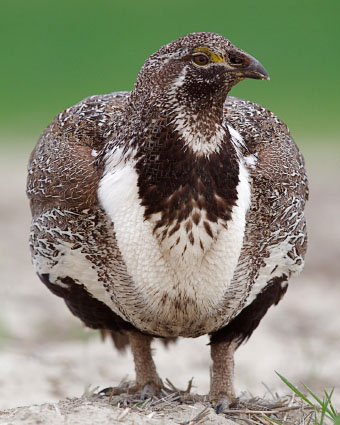 Such an effort will not come easily. While avoiding the need to list a species under the ESA is easy to espouse, the precise nature of the conservation measures required to do so will in many instances be uncertain or controversial.[xxxii] Nonetheless, the opportunity exists to provide species protection now. Doing so will conserve an “icon of western sagebrush ecosystems,”[xxxiii] and perhaps equally, if not more significantly, will establish a community of interest around public lands, resources, and wildlife. We are approaching the threshold of making conservation history; it remains to us to see these efforts to fruition.
Such an effort will not come easily. While avoiding the need to list a species under the ESA is easy to espouse, the precise nature of the conservation measures required to do so will in many instances be uncertain or controversial.[xxxii] Nonetheless, the opportunity exists to provide species protection now. Doing so will conserve an “icon of western sagebrush ecosystems,”[xxxiii] and perhaps equally, if not more significantly, will establish a community of interest around public lands, resources, and wildlife. We are approaching the threshold of making conservation history; it remains to us to see these efforts to fruition.
Michael J. Brennan is an attorney specializing in environmental and natural resources law. Brennan is also a Senior Advisor and Adjunct Professor with the Haub School and Ruckelshaus Institute at the University of Wyoming.
[viii] U.S. Fish & Wildlife Service, Policy for Evaluation of Conservation Efforts When Making Listing Decisions (“PECE Policy”). 68 Fed. Reg. 15100, 15115 (Mar. 28, 2003).
[xi] Colorado Parks and Wildlife, “Colorado Greater Sage-Grouse Conservation Plan” (2008), http://wildlife.state.co.us/WildlifeSpecies/SpeciesOfConcern/Birds/Pages/GreaterSageGrouseConsPlan2.aspx.
[xii] USDA Natural Resources Conservation Service, “Greater Sage-Grouse Habitat Conservation Strategy” (May 2009), ftp://ftp-fc.sc.egov.usda.gov/MT/www/technical/biology/SageGrouseStrategy/SageGrouseStrategy_with_maps.pdf.
[xiii] Scott Streater, “Utah to Develop “Core Area” Approach Modeled on Wyo. Protections” (Feb. 2, 2012), http://www.eenews.net/landletter/stories/1059959348.
[xiv] Oregon Fish and Wildlife, “The Oregon Greater Sage Grouse Conservation and Strategy: A Plan to Maintain and Enhance Populations and Habitat” (April 2011), http://www.dfw.state.or.us/wildlife/sagegrouse/docs/20110422_GRSG_April_Final%2052511.pdf.
[xv] Governor C. L. Otter, “Governor Creates Sage Grouse Task Force” (Mar. 9, 2012), http://gov.idaho.gov/mediacenter/press/pr2012/3Mar/pr_13.html.
[xvi] Department of Interior, “Department of the Interior, Salazar, Mead Reaffirm Commitment toward Development of Landscape Level Greater Sage-Grouse Conservation Strategy in the West” (Dec. 9, 2011), http://www.doi.gov/news/pressreleases/Salazar-Mead-Reaffirm-Commitment-toward-Development-of-Landscape-Level-Greater-Sage-Grouse-Conservation-Strategy-in-the-West.cfm.
[xvii] Western Governors’ Association, “Special Report to Western Governors: Inventory of State and Local Governments’ Conservation Initiatives for Sage Grouse” (Dec. 2012), http://www.westgov.org/policies/doc_download/1666-inventory-of-sage-grouse-conservation-measures-2012.
[xviii] Sage Grouse Task Force, “Process for Developing a Range-wide Conservation Plan for Sage-Grouse” (June 14, 2012), http://www.westgov.org/component/docman/doc_download/1617-sgtf-6-29-12-letter-to-sec-salazar-signed-with-attachment.pdf
[xix] BLM, Instruction Memorandum No. 2010-0871, “Gunnison and Greater Sage Grouse Management Considerations for Energy Development” (Mar. 4, 2010).
[xx] BLM, Instruction Memorandum 2012-0044, “National Greater Sage grouse Planning Strategy” Att. 2 (Dec. 27, 2011).
[xxiii] BLM, “Notice of Intent to Prepare Environmental Impact Statements and Supplemental Impact Statements to Incorporate Greater Sage grouse Conservation Measures into Land Use Plans and Land Management Plans,” 76 Fed. Reg. 77008 (Dec. 9, 2011).
[xxiv] NRCS, “Introduction to NRCS’ New Sage Grouse Initiative: Wildlife Conservation Through Sustainable Ranching” (Feb. 2011).
[xxv] NRCS, “USDA to Protect Prime Sage-Grouse Habitat in Three Western States” (June 30, 2011), www.nrcs.usda.gov/wps/portal/nrcs/detail/national/newsroom/?cid=STELPRDB1044365.
[xxvi] NRCS, “USDA and Interior Announce Working Lands for Wildlife” (Mar. 8, 2012), http://www.nrcs.usda.gov/wps/portal/nrcs/detail/national/newsroom/?cid=STELPRDB1047050.
[xxvii] FWS, “Greater Sage-grouse (Centrocercus urophsianus) Conservation Objectives: Final Report,” (Feb. 2013), http://www.fws.gov/mountain-prairie/species/birds/sagegrouse/COT/COT-Report-with-Dear-Interested-Reader-Letter.pdf.
[xxviii] U.S. Fish and Wildlife Service, “Candidate Conservation Agreements fact sheet,” http://www.fws.gov/endangered/what-we-do/cca.html.
[xxx] FWS, Mountain-Prairie Region, “Environmental Assessment and Draft Greater Sage-grouse Umbrella Candidate Conservation Agreement with Assurances for Wyoming Ranch Management,” (Feb. 7, 2013) http://www.fws.gov/mountain-prairie/pressrel/2013/02072013_GsG%20Agreement.html.
[xxxi] “Candidate Conservation Agreement with Assurances for Greater Sage Grouse in the West Central Planning Area between the Idaho Department of Fish and Game, Natural Resources Conservation Service, and the U.S. Fish and Wildlife Service in Cooperation with the West Central Sage Grouse Local Working Group” (Feb. 2010), http://www.fws.gov/idaho/ConservationPartners/WestCentralIdahoSagegrouseCCAA.pdf.
[xxxii] Manuel Quinones and Phil Taylor, “Mining Industry Calls Some Proposed BLM Protections Illegal,” Greenwire (Mar. 26, 2012), http://www.eenews.net/greenwire/2012/03/26/stories/1059962002.
[xxxiii] BLM, Sage Grouse and Sagebrush Conservation, http://www.blm.gov/wo/st/en/prog/more/sagegrouse.html.

